Sewing Machines
I get asked about the sewing machines I use quite often. If I had more space, I would probably have about a dozen different machines all set up for different tasks. In general, I like simple machines. You can spend a lot of money on a sewing machine with tons of features, different types of stitches, and touch screens. I doubt most people utilize all of these features, and I feel that the more complicated the machine is, the more things that can potentially go wrong with it.
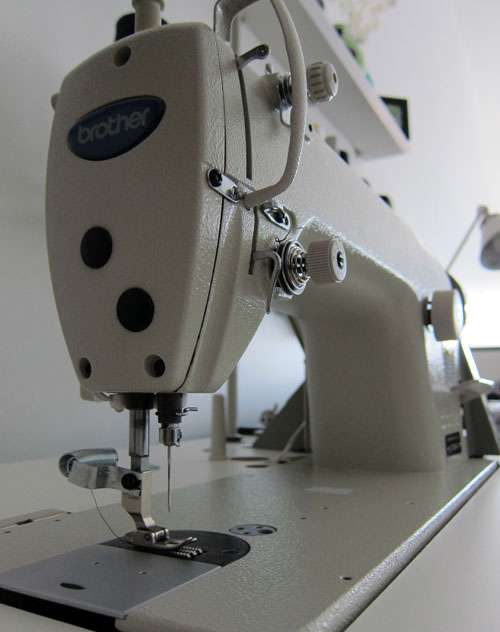
This is the workhorse of our (I share with my wife) sewing studio/office. It is a basic single needle, straight lockstitch industrial sewing machine made by Brother. It goes forwards and backwards and that’s about it. Whereas domestic machines are made to accomplish a variety of things such as straight, zig zag, and stretch stitches, industrial machines are uni-taskers. They do one thing and they do it really well. After all, industrial machines are made for the factory floor where they are expected to do repetitive tasks and run at high speeds all day long.
This machine is built into a table with an oil pan and large motor mounted underneath. It has a 3/4 horsepower motor, is very powerful, and when set at its highest speed, can sew up to 5,500 stitches per minute. I never sew even close to this speed, but it’s nice to know the speed is there if I ever want it. The really nice thing about a big powerful motor is that the industrial machine still has a lot of “punching” power even at low speeds. This machine can sew through five or six layers of heavy denim without flinching while sewing very slowly.
One of my favorite features is a lever that sits right below the surface of the table that I can access with my knee to lift the presser foot. This allows me to keep both hands on whatever I am working on while raising and lowering the foot. Right now we have this machine set up for medium to heavy weight materials with a heavy set of feed dogs.
The industrial machine is made out of steel, which contributes to it being so solid and running so smoothly. The sewing head by itself without the motor and table weighs between 70 and 100 pounds.
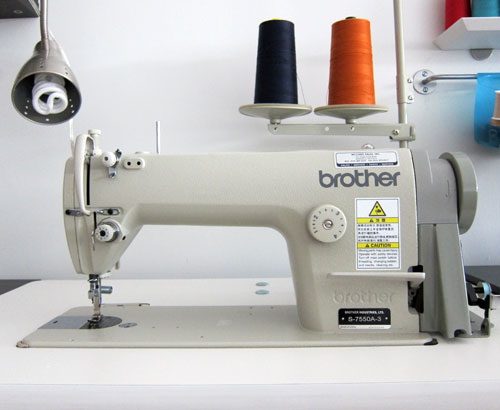
The Juki serger below is still fairly new to me. I bought it in January and am still learning about all of the different things it can do. Like many sergers, this model has two knives that cleanly trim off the edge of the fabric and then overlock the freshly cut edge with any combination of 2, 3, or 4 threads. These overlock stitches prevent the edge of the fabric from fraying. This model has differential feed and can be used with a single needle or double needles depending on which type of stitch I want to create.
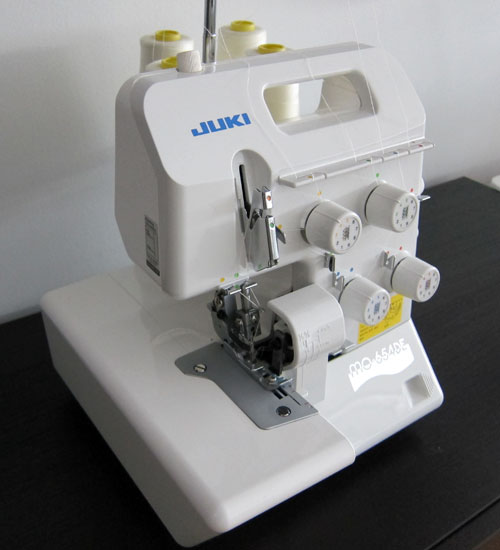
Our oldest machine is a domestic Pfaff. It was one of the first sewing machines my wife bought about six or seven years ago, long before I was even remotely interested in making clothing. It has held up really well over the years. This type of machine is what I would recommend to anyone looking for their first general purpose sewing machine. I don’t think Pfaff makes this particular model any more, but there are other options and brands that are comparable.
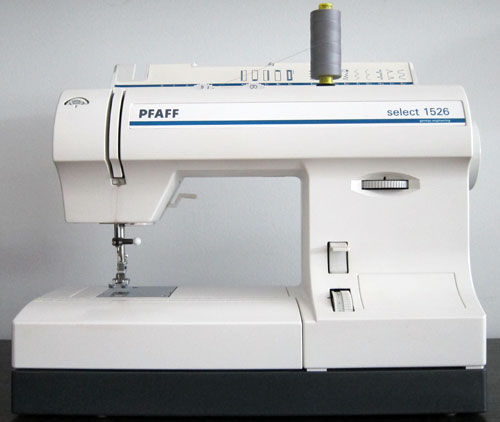

Thanks for sharing, it’s always nice to see what others use. I’ve used the industrial machines at school and cannot wait to get my own someday but until then my second-hand domestic brother is trucking along just fine.
Nice set up. Looks like you got everything to complete great projects.
Also love the studio. Very clean.
Very nice.
I enjoy reading your blog. I’m curious…where to you get your jeans thread and rivets from? Thanks.
Hi Taylor!
I am sooo impressed with your sewing skills! It is unbelieveble how fast you have reached this level in sewing! Congratulation also on the site. It is very hadsome!
Thank you for showing your maschines! I sew just with vintages, including a vintage Juki 3-thread overlock, one of the first hobby overlock produced… Now I am thinking about to buy also a vintage industrial machine!
All the best,
Andrea
Thanks Andrea! I have never sewn with a vintage machine, but if I had more space I would consider getting one.
Taylor
On your industrial Brother, there is a metal spring-looking thing behind the presser foot. In the photo, the bobbin thread appears to be attached to it. What is it called & what is its function? I have one…came in an orphaned attachment box I bought at a secondhand store. TIA!
Hi Cindy,
That metal spring-looking thing is a thread cutter. Inside that spring there is a little razor blade that cuts both threads if you pull them through the spring. The other nice about it (when it works properly) is that the spring will pinch the threads, which keeps the tails in place as you begin sewing again.
Taylor
Hi Taylor, I found you from Peter’s Jeans Sew-along and I was excited to hear you offered denim from an North Carolina mill. My husband’s family is from NC and they worked in the mills–all closed now. It’d be a great story to hear about the history and change that textile industry. Anyway, I’m not making jeans at the moment but will definitely visit when I do!
re: your industrial machine. I really want a simple lockstitch and am holding back simply because of space and inability to move around–but wondering what kind of power the motor requires. We seem to blow fuses around here all the time.
Amy
Hi Amy,
It would be great to hear about the history and change in the textile industry. I might have to seek out a book, or do some research on the topic.
As for our industrial machine, here are the specs: 550 Watts, 110 Volts. It plugs right into a regular household outlet, and we haven’t blown a fuse yet. Ours has a 3/4 horsepower servo motor, vs. the older style clutch motor. The servo motors sound a little different, but they allow you to control the speed more precisely. I love our industrial machine and use it quite a bit more than our other machines.
If yours is a servo, you should be able to lift the presser foot with the foot pedal. You don’t mention whether back tacking is automatic or not. If you have a manual for the config settings of the servo unit, you should be able to set those. You can buy an oem CP for that too.
I’ve become spoiled by the servos, automatic thread trimming etc and could never go back, charming as vintage machines are. I still have some charmers myself. So old they don’t back stitch…
thanks for sharing!
any issues with thick fabrics and your juki serger (i.e. have you been using on your denim projects)?
Dan,
No, I haven’t had any issues with thick fabrics, but even with my denim projects, I’m never running more than 3 or so layers through the serger.
Taylor
I meant to ask Taylor, is there a lot of work involved in maintaining the Brother machine? Changing the oil, that kind of thing? I’ve seen some marked “semi industrial” and they (intuitively) seem to have less of a maintenance overhead… but that’s pure guesswork on my part.
Hi Roy,
I haven’t had to do anything to the machine since I bought it. The oil needs to be maintained at a certain level, but not changed all that often. I suppose this would depend on how much you use it. The dealer told me not to worry about changing the oil unless the color of the oil changes. So far this Brother industrial has been completely maintenance free other than basic lint cleaning around the bobbin case and throat plate.
Hi,
I’m just getting in to sewing and would love to make my own jeans someday.
I’m starting out with a Singer 128k, only issue is the feedogs don’t run the whole length on the right side so i’ve now got a Singer 306k which needs some work before i can sew anything never mind jeans!
I love the mechanical nature of them and find they sail through denim and other thick materials no problem.
Hi again Taylor
I’m now up and running and enjoying my early experiments with quite a basic vintage machine. It’s extremely meditative!
Quick question though – from the machines listed in your post, which do you use to, for example, hem your jeans? I’m guessing you can’t do it on your industrial model, is that right?
Cheers again mate.
Roy
Hi Roy,
Awesome! I’m sure you will enjoy it. I actually do use my industrial machine to hem my jeans. No problems there. I just have to make sure to keep the opposite side of the hem out of the way of the foot/needle.
Taylor
You know, I never thought of that! It’s simple common sense. 🙂
Thanks Taylor – I think I’m good to go with that in mind.
Hi,
Are you able to use the Juki serger for sewing double needle belt loops for your jeans projects? If you do, do you then use a belt loop foot?
Thanks,
Johan
Johan,
No, I can’t use this serger for belt loops. It does not do a cover-stitch. Some 5 thread sergers can do a cover stitch, but they require you to “convert” them back and forth between overlock stitches and cover-stitches.
I make belt loops the old fashioned way, with an iron and a single needle machine.
Taylor-
Are you happy with the Juki serger you are using for denim? Would you buy the same one today knowing what you know now?
Thanks again,
Johan
So far this serger has been great, although I don’t know how it compares to other models because I’ve only used a couple. It does fine with denim, but I only use it in a few limited places.
I wouldn’t say it is designed for really heavy fabrics. For the few places I need it on a pair of jeans it is perfect, but if you were always using heavy denim, then you might want to look into an industrial serger. One thing it doesn’t like to do (and this is the case with lots of sewing machines and the other sergers I’ve used) is move from thicker to thinner materials and vice versa. The stitching tends to get a little loopy in these areas.
My first machine was a beautiful baby teal, vintage 50s-60s Brother clone. I brought it back to the store though to exchange it for a Janome Jem Gold. The vintage machine was solid cast iron and sewed soooooo smoothly, albeit only a straight stitch.
I brought it back because I thought it would be hard to hem sleeves on it. It didn’t have a freestanding arm like the newer machines. It was mounted onto a wood cabinet like your industrial machine. Is it indeed hard to hem sleeves on it?
Hi Rachel,
These days I use the industrial machine for all of my projects. There are times when the freestanding arm feature would be nice, but I don’t think it is an absolute necessity for most of the things I am making.
I have a Juki heavy duty industrial for automotive upholstery. You say that you sew everything on your industrial; what size needle do you use in your Brother to sew shirting and lighter materials?
I’m using a size 70/10 for lighter weight materials. If your machine is for heavy duty use, you may want to change the feed dogs also. I have some that are more aggressive than others.
What are your thoughts on on vintage Singer 15-91 (circa 1951)? Also, I am looking to get a serger–does the the Juki you have do chain stitching and coverstitching? I know some people end up buying two different sergers.
I’ve heard great things about vintage Singers in general, but I’ve never used one myself, so can’t say for sure. Lots of people love those old machines. If they are properly maintained, they seem to last a long time.
You have to move to the 5 thread version of this serger to do chain stitching, and you might need a different Juki line altogether for a cover stitch. Some people end up buying a serger and then a separate cover stitch machine. I’ve heard that converting back and forth between serging and cover stitching on five thread sergers is a pain.
Taylor-
I’m looking for large gold cone jeans thread. Where would you recommend me buying such items? I’m using cone mills 11oz unsan selvage. THanks
Now that you have an industrial single needle heavy duty machine, it’s time to move up to an industrial serger. You can get a five thread used Juki for around $1K, maybe less if you negotiate. You will need an industrial serger for the same reasons you use that Brother SN. Try one out and you will see what I mean. One of my sewing contractor friends was bragging about his heavy duty Juki serger that can trim and sew that back rise seam that ends up being a half inch thick where all the flat felled seams meet. So consider going really heavy duty if you continue to make denim jeans.
I have an industrial brother sewing machine and looking for a foot that will make loops for wedding dress corset back, a coligue of mine bought one which makes the loop without having to turn it inside out, impossible to do longer lengths reqired for dresses